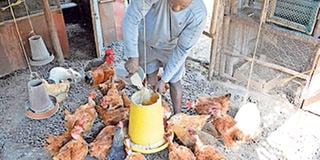Solar bulbs, gas heater keep farmer's chickens warmer

Charles Owiti feeds chicken that he keeps in his farm in Kajulu, Kisumu County. He is the proprietor of Joe Fresh Farm, where he also rears rabbits on part of the one-acre farm. PHOTO | ELIZABETH OJINA | NATION MEDIA GROUP
What you need to know:
- He started the farm in August 2016, ploughing in the business Sh400,000 drawn from his savings and a loan from a family member.
- As part of pest and disease control, he vaccinates the chicks against Gumboro at day 10 and Newcastle at day 20 and 30.
- To disinfect the sawdust, he spreads it on black polythene sheet then sprays on it a disinfect. He then dries the sawdust in the sun until it is dry before putting in the coops.
- His challenge is the rising cost of feeds, with a 50kg bag of chicken starter going for Sh3,300 and a 50kg bag of pellets atSh3,100.
Obwolo village in Mamboleo, Kisumu County, is a rather quiet neighbourhood, with most people living in homesteads that are fenced with hedges.
It is here that Charles Owiti runs his Joe Fresh Farm, where he rears chickens and rabbits on part of the one-acre farm.
“I keep broilers, Rainbow roosters and Kenbro birds,” says the 39-year-old, who sold most of his 258 birds over Christmas and remained with 25.
He started the farm in August 2016, ploughing in the business Sh400,000 drawn from his savings and a loan from a family member.
“The money went into setting up the poultry house, buying drinkers, feeders, 250 chicks and their feeds.”
When he started, the farmer used charcoal brooders to keep the chicks warm, what consumed plenty of money.
But he has now switched to solar bulbs and a gas heater. He installed a solar panel on the chicken coop and he now uses solar lamps for lighting.
“They are cheaper since there are no extra costs as in the case of electricity where one pays bills every month. Also, with frequent power outages, you can be sure I don’t care about the blackouts.”
The farmer further uses catalytic infra red gas heater to keep the chickens warmer, noting that it is safer than using charcoal.
“It’s environmentally friendly. Gas costs Sh2,100. Charcoal is Sh2,000 and I had to use three bags a month. That’s Sh6,000. So I save a lot.”
As part of pest and disease control, he vaccinates the chicks against Gumboro at day 10 and Newcastle at day 20 and 30.
VENTURE INTO VALUE ADDITION
“I also disinfect sawdust before putting it in the house and I have a footbath to keep pests and diseases at bay,” says the disaster management Masters student at Masinde Muliro University of Science and Technology.
To disinfect the sawdust, he spreads it on black polythene sheet then sprays on it a disinfect. He then dries the sawdust in the sun until it is dry before putting in the coops. He feeds the birds thrice a day and gives them plenty of water to drink.
“We target to sale the broilers when they attain 1kg in slightly over a month at Sh420 each,” explains the farmer.
For the other birds, we sell each when they are about 1.4kg at Sh650, with the farmer selling some of the chickens to Tumaini supermarket and Nightingale Hospital in Kisumu.
“I market my poultry products via social media platforms such as Facebook, and I have a website,” says Owiti, who also sales 50kg and 70kg chicken droppings at Sh90 and Sh120 respectively.
His challenge is the rising cost of feeds, with a 50kg bag of chicken starter going for Sh3,300 and a 50kg bag of pellets atSh3,100.
“Some of the chicks sold in the market are also of poor quality leading to losses because they die. I am currently working on restocking with 300 chicks.”
The farmer plans to venture into value addition, expand his farm and go into hatchery production in about five years.
Maseno University’s Department of Agriculture Head Prof Matthew Dida says farmers have an option of making their own feeds to cut cost of production.
“But one should be trained on feed formulation to be able to make a balanced feeds for broilers,” says Prof Dida.
“There are a variety of raw materials available for feed formulations such sunflower seedcake, cotton seedcake and maize germ.”




